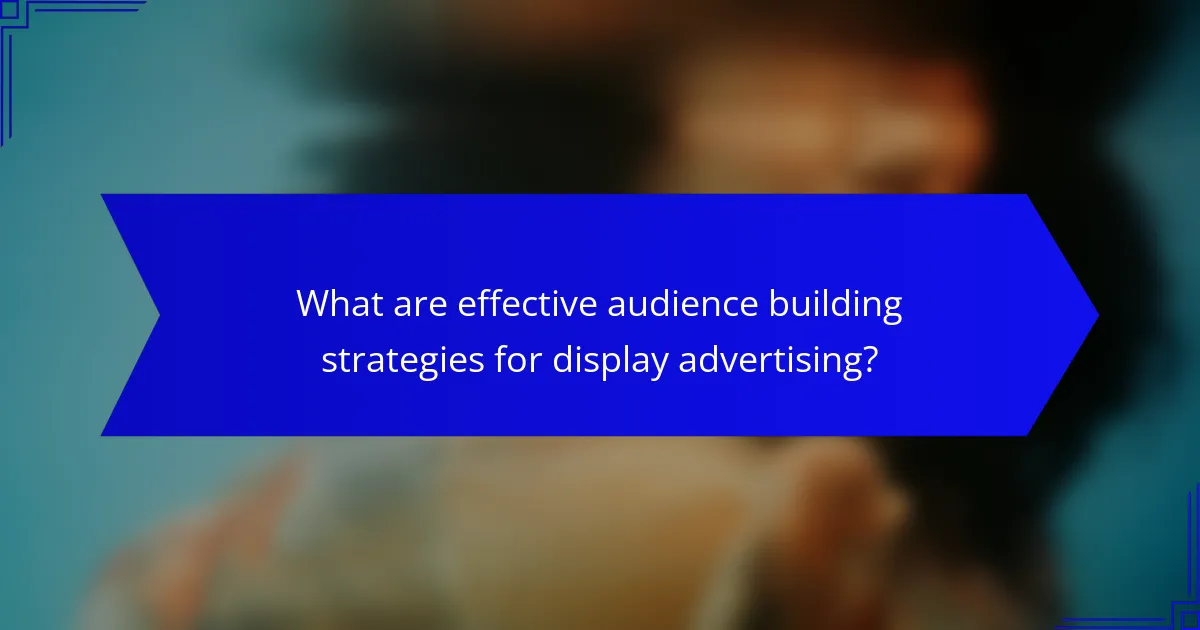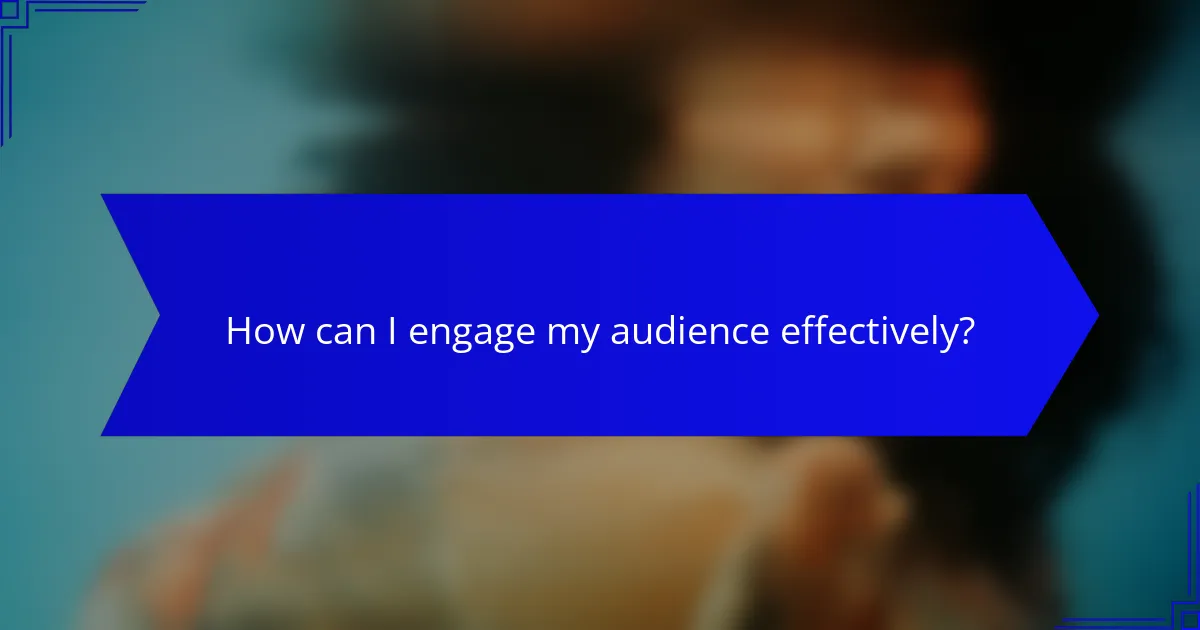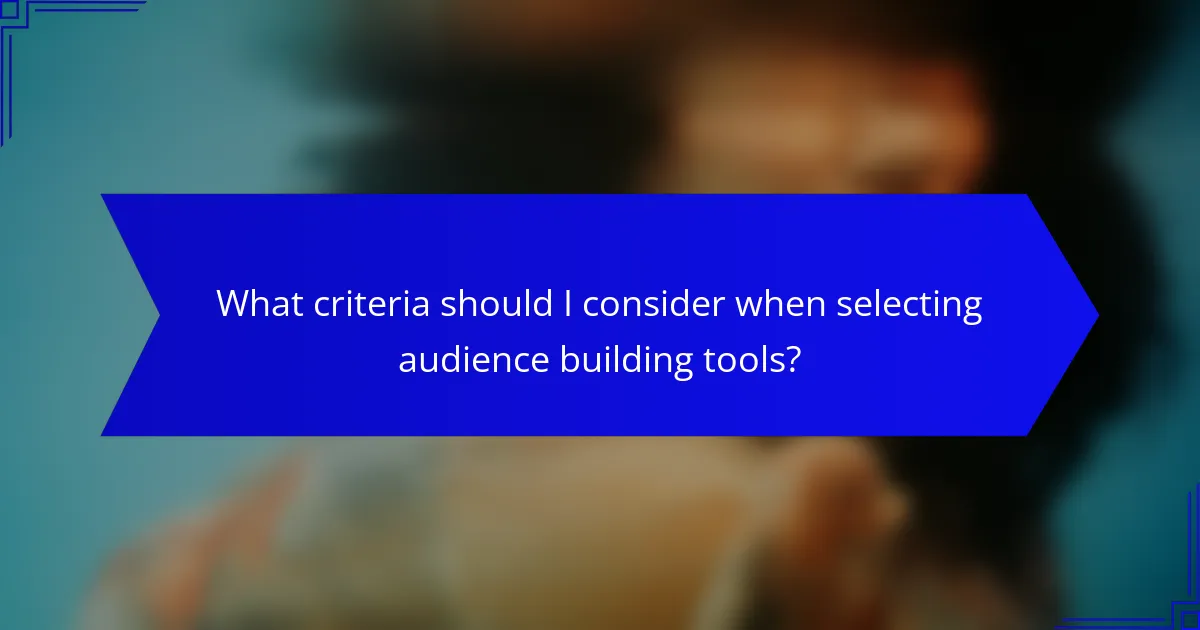Building an audience is essential for successful display advertising, and it involves creating engaging content, utilizing social media platforms, and establishing direct communication with potential customers. The choice of platforms should align with your target demographic and marketing objectives, as each offers distinct benefits for audience engagement. By employing effective strategies, you can foster interaction and create a dynamic experience that resonates with your audience, ultimately driving conversions.

What are effective audience building strategies for display advertising?
Effective audience building strategies for display advertising focus on creating engaging content, leveraging social platforms, and fostering direct communication with potential customers. These methods enhance visibility and drive targeted traffic, ultimately leading to increased conversions.
Content marketing
Content marketing involves creating valuable and relevant content to attract and engage a specific audience. This can include blog posts, videos, infographics, and more, tailored to the interests of your target demographic. By providing useful information, you can establish authority and build trust, which are crucial for audience retention.
Consider using SEO techniques to optimize your content for search engines, increasing organic visibility. Regularly updating your content and sharing it across various channels can further enhance reach and engagement.
Social media engagement
Social media engagement is key to building an audience through display advertising. Platforms like Facebook, Instagram, and Twitter allow for direct interaction with users, enabling brands to create a community around their products or services. Regularly posting engaging content and responding to comments can foster loyalty and encourage sharing.
Utilize targeted ads on these platforms to reach specific demographics based on interests, behaviors, and location. This approach can significantly enhance the effectiveness of your display advertising campaigns.
Email marketing campaigns
Email marketing campaigns are a powerful way to build and maintain an audience. By collecting email addresses through sign-ups or lead magnets, you can send personalized content directly to interested users. This method allows for targeted messaging that can drive traffic to your display ads.
Segment your email list based on user behavior and preferences to improve engagement rates. Regular newsletters, promotional offers, and personalized recommendations can keep your audience engaged and encourage conversions.
Influencer partnerships
Influencer partnerships involve collaborating with individuals who have a significant following in your niche. By leveraging their credibility and reach, you can effectively promote your display advertising to a broader audience. Choose influencers whose values align with your brand for authentic promotion.
Consider micro-influencers, who often have higher engagement rates and more targeted audiences. This can lead to more effective campaigns and a better return on investment.
Community building
Community building focuses on creating a loyal customer base that actively engages with your brand. This can be achieved through forums, social media groups, or events that encourage interaction among users. A strong community can amplify your display advertising efforts through word-of-mouth and shared experiences.
Encourage user-generated content and feedback to foster a sense of belonging. Regularly engaging with your community can help you understand their needs and preferences, allowing you to tailor your advertising strategies effectively.

Which platforms are best for audience building?
The best platforms for audience building depend on your target demographic and marketing goals. Popular options include social media channels, search engines, and display networks, each offering unique advantages for reaching and engaging potential audiences.
Facebook Ads
Facebook Ads are highly effective for audience building due to their extensive targeting options. You can reach specific demographics based on interests, behaviors, and location, making it easier to connect with your ideal audience.
Consider using a mix of ad formats, such as image, video, and carousel ads, to engage users effectively. A budget of as little as $5 per day can help you test different strategies and optimize your campaigns over time.
Google Display Network
The Google Display Network allows you to showcase ads across millions of websites, apps, and videos. This platform is ideal for building brand awareness and reaching users who may not be actively searching for your products or services.
Utilize targeting options like contextual targeting and remarketing to engage users based on their online behavior. A budget of around $10 to $20 per day can help you gain visibility and attract potential customers.
Instagram is a visually-driven platform that excels at audience engagement, particularly among younger demographics. Utilizing eye-catching images and videos can help you capture attention and build a loyal following.
Consider using Instagram Stories and Reels to showcase your brand’s personality and connect with users in a more authentic way. A budget of $5 to $15 per day can be effective for testing various ad formats and reaching your target audience.
LinkedIn is the premier platform for B2B audience building, allowing you to connect with professionals and decision-makers. Sponsored content and InMail campaigns can help you reach a highly targeted audience based on industry, job title, and company size.
Investing around $10 to $30 per day can yield significant returns if your goal is to generate leads or establish authority in your field. Focus on providing valuable content that resonates with your audience’s professional interests.
Twitter is effective for real-time engagement and building a community around your brand. It allows you to share updates, interact with followers, and participate in trending conversations relevant to your industry.
Consider using promoted tweets to increase visibility and reach a broader audience. A daily budget of $5 to $20 can help you test different messaging strategies and engage users effectively.

How can I engage my audience effectively?
Engaging your audience effectively involves using strategies that foster interaction and connection. By implementing various techniques, you can create a more dynamic experience that resonates with your audience and encourages their participation.
Interactive content
Interactive content, such as quizzes, polls, and surveys, invites your audience to participate actively rather than passively consume information. This type of content not only increases engagement but also provides valuable insights into your audience’s preferences and interests.
Consider incorporating tools like interactive infographics or calculators that allow users to input data and receive personalized results. This approach can significantly enhance user experience and retention.
Personalized messaging
Personalized messaging tailors your communication to individual audience members based on their behaviors, preferences, and demographics. This strategy can lead to higher engagement rates as people are more likely to respond to content that feels relevant to them.
Utilize data analytics to segment your audience and craft messages that resonate with each group. For example, sending targeted emails based on past purchases or interests can drive better engagement and conversion rates.
Regular updates
Providing regular updates keeps your audience informed and engaged with your content. Consistency in communication helps build trust and anticipation among your audience, encouraging them to return for more.
Establish a content calendar to schedule updates across various platforms, whether it’s weekly newsletters, blog posts, or social media updates. Aim for a frequency that maintains interest without overwhelming your audience.
Feedback loops
Creating feedback loops allows your audience to share their thoughts and opinions, fostering a sense of community and involvement. This two-way communication can enhance engagement and improve your offerings based on audience input.
Encourage feedback through comments, surveys, or direct messages. Actively responding to audience feedback shows that you value their opinions and are willing to adapt based on their needs.
Gamification techniques
Gamification techniques incorporate game-like elements into your content to motivate and engage your audience. This can include points, badges, leaderboards, or challenges that encourage participation and competition.
Implementing gamification can be as simple as rewarding users for completing tasks or engaging with your content. For instance, offering discounts or exclusive content for reaching certain milestones can drive engagement and loyalty.

What criteria should I consider when selecting audience building tools?
When selecting audience building tools, consider factors such as target audience demographics, integration capabilities, and cost-effectiveness. These criteria will help ensure that the tools you choose align with your goals and provide the best return on investment.
Target audience demographics
Understanding your target audience demographics is crucial for effective audience building. Analyze factors such as age, gender, location, and interests to select tools that can help you reach the right people. For instance, if your audience skews younger, platforms like TikTok or Instagram may be more effective than Facebook.
Utilize tools that offer detailed demographic insights, allowing you to tailor your content and strategies accordingly. This ensures that your messaging resonates with your audience and increases engagement rates.
Integration capabilities
Integration capabilities refer to how well the audience building tools work with your existing systems, such as CRM software or email marketing platforms. Choose tools that can seamlessly connect with your current technology stack to streamline your processes and data management.
For example, if you use Salesforce for customer relationship management, look for audience building tools that offer direct integration with Salesforce. This can enhance data flow and improve your ability to analyze audience behavior effectively.
Cost-effectiveness
Cost-effectiveness is an essential consideration when selecting audience building tools. Evaluate the pricing models of various tools, including subscription fees, pay-per-use, or tiered pricing based on features. Aim for tools that provide the best features for your budget without compromising on quality.
Consider free trials or basic plans to test the tools before committing to a paid version. This allows you to assess their effectiveness in building your audience while minimizing upfront costs. Additionally, keep an eye out for discounts or bundled offers that can enhance overall value.
